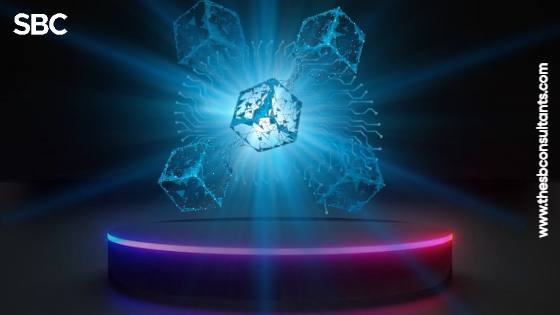The Intersection Between AI And Blockchain Technology
Blockchain and Artificial Intelligence (AI) are two revolutionary technologies that have gained significant traction in recent years. As the world becomes increasingly digital, the intersection of AI and blockchain technology holds immense potential for transforming various industries. In this blog, we will delve into the intricacies of both technologies, exploring their individual characteristics before unveiling the synergies that arise when they converge.
Introduction
A. Definition of AI and Blockchain
AI, or Artificial Intelligence, refers to the simulation of human intelligence in machines programmed to think and learn like humans. On the other hand, blockchain is a decentralized, distributed ledger technology that ensures secure and transparent transactions. The combination of these two powerful technologies opens up new possibilities and avenues for innovation.
B. Rapid Growth and Adoption
Both AI and blockchain technologies have experienced unprecedented growth and adoption across diverse sectors. As businesses seek advanced solutions for efficiency and security, the intersection of these technologies emerges as a game-changer.
Understanding AI Technology
A. Machine Learning
Machine Learning (ML) is a subset of AI that enables systems to learn and improve from experience without explicit programming. It plays a crucial role in enhancing AI capabilities, allowing systems to make data-driven decisions and predictions.
B. Natural Language Processing
Natural Language Processing (NLP) focuses on the interaction between computers and human language. Through NLP, AI systems can understand, interpret, and generate human-like language, paving the way for improved communication between machines and users.
C. Computer Vision
AI’s Computer Vision capabilities enable machines to interpret and make decisions based on visual data. This technology finds applications in facial recognition, image analysis, and autonomous vehicles.
Unraveling Blockchain Technology
A. Decentralization
Blockchain operates on a decentralized network of computers, ensuring that no single entity has control over the entire system. This decentralization eliminates the need for intermediaries, reducing the risk of fraud and enhancing transparency.
B. Smart Contracts
Smart contracts are self-executing contracts with the terms of the agreement directly written into code. Blockchain’s smart contract feature automates and enforces contract execution, streamlining processes and minimizing the potential for disputes.
C. Cryptocurrencies
Blockchain is synonymous with cryptocurrencies like Bitcoin and Ethereum. These digital currencies leverage blockchain technology for secure and transparent peer-to-peer transactions.
The Synergy Between AI and Blockchain
A. Enhanced Security
The marriage of AI and blockchain enhances security measures. AI algorithms can detect anomalies and potential threats, while blockchain’s immutability ensures that once data is recorded, it cannot be altered, providing an additional layer of protection.
B. Decentralized AI Applications
Integrating AI with blockchain allows for the development of decentralized applications. These applications operate on a peer-to-peer network, offering increased privacy and security compared to centralized counterparts.
C. Improved Data Privacy
Blockchain’s cryptographic principles and AI’s ability to manage and analyze vast amounts of data contribute to improved data privacy. Users can have greater control over their personal information, reducing the risk of data breaches.
Real-world Applications
A. Healthcare
The healthcare industry benefits from the intersection of AI and blockchain through secure medical record management, drug traceability, and AI-assisted diagnostics.
B. Finance
In finance, AI-driven predictive analytics combined with blockchain’s transparent and secure transaction records streamline processes such as fraud detection and identity verification.
C. Supply Chain
Blockchain ensures transparency in the supply chain, while AI optimizes logistics and predicts demand, resulting in more efficient and responsive supply chain management.
Challenges and Solutions
A. Scalability
Scalability remains a challenge in the integration of AI and blockchain. Addressing this requires continuous technological advancements and collaborative efforts within the tech community.
B. Integration Issues
The seamless integration of AI and blockchain poses challenges, primarily due to differing architectures. Innovations in interoperability solutions are essential to overcome these integration hurdles.
C. Regulatory Concerns
The convergence of AI and blockchain raises regulatory questions regarding data ownership, accountability, and ethical considerations. Industry-wide standards and regulations must evolve to address these concerns.
Future Trends
A. AI-Blockchain Fusion
The fusion of AI and blockchain is poised to evolve further, leading to more sophisticated applications with enhanced capabilities. Innovations in this space are expected to redefine industries and user experiences.
B. Advancements in Decentralized AI
Advancements in decentralized AI will likely result in more user-centric applications, providing individuals with greater control over their data and interactions in the digital realm.
C. Impact on Industries
Industries across the board will experience significant transformations as the integration of AI and blockchain becomes more pervasive. From manufacturing to entertainment, the impact will be profound and far-reaching.
Conclusion
In conclusion, the intersection between AI and blockchain technology heralds a new era of innovation and possibilities. The complementary strengths of these two technologies address challenges in security, privacy, and efficiency, paving the way for transformative changes across industries.
FAQs
1. How does blockchain enhance data security in AI applications?
– Blockchain’s immutability ensures that once data is recorded, it cannot be altered, providing an additional layer of security to AI applications.
2. What are the key challenges in integrating AI and blockchain?
Scalability, integration issues, and regulatory concerns pose challenges in seamlessly integrating AI and blockchain technologies.
3. What industries benefit the most from the convergence of AI and blockchain?
Healthcare, finance, and supply chain industries experience significant benefits from the synergy of AI and blockchain.
4. How do smart contracts streamline processes in the business sector?
Smart contracts automate and enforce contract execution, reducing the potential for disputes and streamlining various business processes.
5. What can we expect in the future of AI-Blockchain fusion?
The future holds the promise of more sophisticated applications and enhanced capabilities, redefining industries and user experiences.

